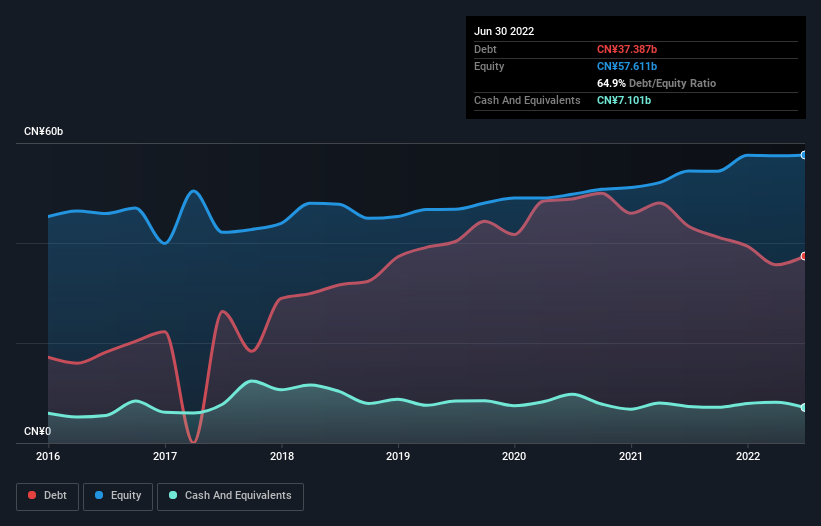- Hong Kong
- /
- Real Estate
- /
- SEHK:1528
Does Red Star Macalline Group (HKG:1528) Have A Healthy Balance Sheet?
David Iben put it well when he said, 'Volatility is not a risk we care about. What we care about is avoiding the permanent loss of capital.' It's only natural to consider a company's balance sheet when you examine how risky it is, since debt is often involved when a business collapses. Importantly, Red Star Macalline Group Corporation Ltd. (HKG:1528) does carry debt. But should shareholders be worried about its use of debt?
Why Does Debt Bring Risk?
Debt and other liabilities become risky for a business when it cannot easily fulfill those obligations, either with free cash flow or by raising capital at an attractive price. If things get really bad, the lenders can take control of the business. However, a more frequent (but still costly) occurrence is where a company must issue shares at bargain-basement prices, permanently diluting shareholders, just to shore up its balance sheet. Of course, debt can be an important tool in businesses, particularly capital heavy businesses. The first step when considering a company's debt levels is to consider its cash and debt together.
View our latest analysis for Red Star Macalline Group
What Is Red Star Macalline Group's Debt?
As you can see below, Red Star Macalline Group had CN¥37.4b of debt at June 2022, down from CN¥43.4b a year prior. However, it does have CN¥7.10b in cash offsetting this, leading to net debt of about CN¥30.3b.

How Healthy Is Red Star Macalline Group's Balance Sheet?
We can see from the most recent balance sheet that Red Star Macalline Group had liabilities of CN¥30.0b falling due within a year, and liabilities of CN¥46.4b due beyond that. On the other hand, it had cash of CN¥7.10b and CN¥6.27b worth of receivables due within a year. So it has liabilities totalling CN¥63.0b more than its cash and near-term receivables, combined.
This deficit casts a shadow over the CN¥17.3b company, like a colossus towering over mere mortals. So we'd watch its balance sheet closely, without a doubt. At the end of the day, Red Star Macalline Group would probably need a major re-capitalization if its creditors were to demand repayment.
In order to size up a company's debt relative to its earnings, we calculate its net debt divided by its earnings before interest, tax, depreciation, and amortization (EBITDA) and its earnings before interest and tax (EBIT) divided by its interest expense (its interest cover). Thus we consider debt relative to earnings both with and without depreciation and amortization expenses.
Red Star Macalline Group shareholders face the double whammy of a high net debt to EBITDA ratio (6.4), and fairly weak interest coverage, since EBIT is just 2.0 times the interest expense. This means we'd consider it to have a heavy debt load. More concerning, Red Star Macalline Group saw its EBIT drop by 8.1% in the last twelve months. If it keeps going like that paying off its debt will be like running on a treadmill -- a lot of effort for not much advancement. The balance sheet is clearly the area to focus on when you are analysing debt. But it is future earnings, more than anything, that will determine Red Star Macalline Group's ability to maintain a healthy balance sheet going forward. So if you want to see what the professionals think, you might find this free report on analyst profit forecasts to be interesting.
Finally, a company can only pay off debt with cold hard cash, not accounting profits. So we always check how much of that EBIT is translated into free cash flow. In the last three years, Red Star Macalline Group's free cash flow amounted to 32% of its EBIT, less than we'd expect. That's not great, when it comes to paying down debt.
Our View
To be frank both Red Star Macalline Group's net debt to EBITDA and its track record of staying on top of its total liabilities make us rather uncomfortable with its debt levels. And even its EBIT growth rate fails to inspire much confidence. Taking into account all the aforementioned factors, it looks like Red Star Macalline Group has too much debt. While some investors love that sort of risky play, it's certainly not our cup of tea. When analysing debt levels, the balance sheet is the obvious place to start. But ultimately, every company can contain risks that exist outside of the balance sheet. Case in point: We've spotted 3 warning signs for Red Star Macalline Group you should be aware of, and 1 of them is a bit unpleasant.
At the end of the day, it's often better to focus on companies that are free from net debt. You can access our special list of such companies (all with a track record of profit growth). It's free.
New: AI Stock Screener & Alerts
Our new AI Stock Screener scans the market every day to uncover opportunities.
• Dividend Powerhouses (3%+ Yield)
• Undervalued Small Caps with Insider Buying
• High growth Tech and AI Companies
Or build your own from over 50 metrics.
Have feedback on this article? Concerned about the content? Get in touch with us directly. Alternatively, email editorial-team (at) simplywallst.com.
This article by Simply Wall St is general in nature. We provide commentary based on historical data and analyst forecasts only using an unbiased methodology and our articles are not intended to be financial advice. It does not constitute a recommendation to buy or sell any stock, and does not take account of your objectives, or your financial situation. We aim to bring you long-term focused analysis driven by fundamental data. Note that our analysis may not factor in the latest price-sensitive company announcements or qualitative material. Simply Wall St has no position in any stocks mentioned.
About SEHK:1528
Moderate growth potential and slightly overvalued.
Market Insights
Community Narratives



